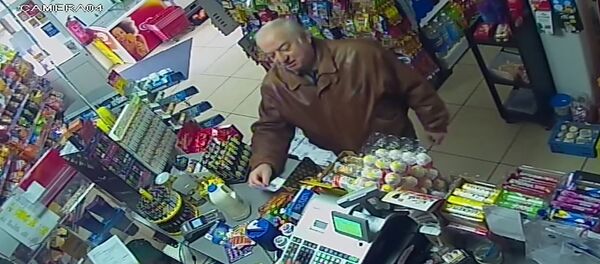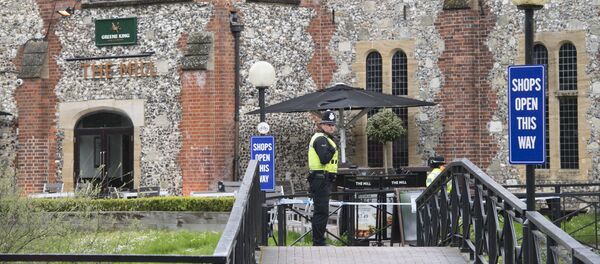On 16th April, the New York Times published a glowing profile of Gina Haspel, who in May 2018 became the seventh director of the Central Intelligence Agency.
The article referred to Haspel — the former head of a CIA 'black site' in Thailand at which an indeterminate number of suspected terrorists were viciously tortured — as an "adept tactician" blessed with "good listening, empathy and an ability to connect", and discussed the difficulties the intelligence chief faced in ensuring "her voice is heard at the White House", due to the intransigence of President Donald Trump, whose administration treats national security professionals "with deep skepticism".
READ MORE: Media Reveal Who Swayed Trump to Kick Russian Diplomats Out of US
So far, so obsequious — but buried in the hagiography is a fascinating disclosure. In a section titled ‘The keys to talking to Trump? Realism and emotion', authors Julian E. Barnes and Adam Goldman document how Haspel "solidified her reputation" as one of the "most skilled briefers" of the President.
Following the 4th March 2018 poisoning of former spy Sergei Skripal and his daughter Yulia in Salisbury, UK, top national security officials are said to have gathered inside the White House to discuss with Trump how Washington should respond — at the time, Whitehall was preparing to expel dozens of Russian diplomats from the UK, and aggressively pushing various key international allies to follow suit.
The Official Skripal Story is a Dead Duck — One of the striking things about the official Skripal story is the way its more wildly improbable aspects have been released to the mainstream media over a long period, so as to manage their impact. So, for https://t.co/LVNoRKdKhK
— Craig Murray (@CraigMurrayOrg) April 17, 2019
Trump was said to have initially dismissed the significance of the poisoning, allegedly characterising it as "legitimate spy games, distasteful but within the bounds of espionage". However, Haspel lobbied the President to expel 60 Russian diplomats from the US — and persuaded Trump to take the "strong option" by showing him the Skripals "were not the only victims of Russia's attack".
"Ms. Haspel showed pictures the British government had supplied her of young children hospitalized after being sickened by the Novichok nerve agent that poisoned the Skripals. She then showed a photograph of ducks British officials said were inadvertently killed by the sloppy work of the Russian operatives. Ms. Haspel was not the first to use emotional images to appeal to the president, but pairing it with her hard-nosed realism proved effective: Mr. Trump fixated on the pictures of the sickened children and the dead ducks. At the end of the briefing, he embraced the strong option," the article states.
Lame Ducks
This small excerpt raises innumerable questions about the ever-mystifying Salisbury incident. Firstly, the images apparently provided to Haspel by the British government have never been published, or even mentioned, by the British media.
Given Whitehall's determination to blame and diplomatically punish the Russian state for the poisoning before a motive had been established, any perpetrators identified, or other basic facts ascertained — in the face of significant public disapproval, and opposition leader Jeremy Corbyn demanding action be informed by evidence — it's entirely inconceivable that if these pictures existed, they wouldn't have been provided to major news outlets and prominently publicised. If they were sufficiently impactful to convince a sceptical US President to support Whitehall's strategy, hesitant British citizens may well have been similarly swayed.
CIA chief Gina Haspel ’used images supplied by UK govt of #Skripal Novichok poisoned children and ducks to persuade Trump to take hard line on Russia’https://t.co/McjtogSRaU
— Charles Shoebridge (@ShoebridgeC) April 16, 2019
NB There were no Skripal poisoned children or ducks. So if story true, who lied: Haspel, UK govt or both?
Moreover though, since March 2018 no UK media outlet, government minister/spokesperson, health professional or law enforcement official has once claimed a single child was "sickened" after coming into contact with so-called "Novichok" (there have likewise been no reports of any waterfowl having tragically died due to the nerve agent). Again, it's utterly imaginable that had a child suffered adverse effects from the nerve agent, it wouldn't have been widely reported.
There could be several explanations for this seeming anomaly. To name two of the most unsettling:
- Several children were hospitalised, and several ducks did die, but for reasons unclear the British government didn't inform the public and prevented the children and their parents from revealing they'd been affected, while secretly communicating the fact to other governments in literally graphic detail.
- Counterfeit and/or misleading images may have been produced by persons unknown to bolster Britain's case for concerted international action, and further been relayed to Haspel (if not other overseas officials), conning her and Trump into backing its mass-expulsion policy.
Alternatively of course, perhaps the stirring tale of Haspel converting the reticent President with impactful images is mere gossip, or spin — after all, the article's authors didn't discuss the episode with the CIA chief herself, but based their article on interviews "with more than a dozen current and former intelligence officials who have briefed or worked alongside her".
However, even if the explanation is quite so anodyne, that in turn raises major questions about how and why the individual(s) who relayed the story to Barnes and Goldman came to believe children and ducks had been affected by Novichok.
Shifting Chronicle
The official narrative of the Salisbury incident is perpetually in flux. Seemingly each and every article, news segment, official statement or documentary about any element of the case contains new information, requiring the established account to be at least partially rewritten and/or contradicting established elements of the story.
To name but two significant instances of this strange phenomenon in recent memory, on 19th January it was revealed 16-year-old Abigail McCourt had won a 'Lifesaver Award' for giving first-aid to the Skripals after finding them unconscious on a public bench in the centre of Salisbury. Accompanying reports indicated she'd been the first person to notice the collapsed father and daughter, and had quickly alerted her mother Alison — together, they provided potentially life-saving medical assistance to Sergei and Yulia.
The story was somewhat at odds with the official timeline, as advocated by Whitehall and the Metropolitan Police, which stated an off-duty doctor and nurse had found the Skripals — but moreover, Abigail's award announcement also revealed her mother wasn't merely a nurse, but the Chief Nursing Officer for the British Army, with the rank of Colonel.
Similarly, on 3rd March the BBC reported police only "realised the seriousness" of the Salisbury incident after Googling the name Sergei Skripal — while the information wasn't in fact new (similar claims were made in Panorama documentary Salisbury Nerve Agent Attack — The Inside Story in November the previous year), the article indicated the first police officer on the scene was Sergeant Tracey Holloway.
Elements of the official narrative also bizarrely and frequently vanish without warning or explanation — a key example being the Skripals giving bread to three local boys to feed to ducks in Salisbury's Avon Playground at approximately 1:45pm on 4th March. The incident was initially widely reported, with The Daily Mail claiming the children — one of whom apparently ate some of the bread given to them by the Skripals — had been "rushed to hospital for blood tests amid fears they'd been poisoned", although the children were entirely unharmed, and discharged from hospital having been given "the all-clear".
"To try to kill Skripal is one thing, but now it seems children may have been caught up in it. It shows whoever did this didn't care who they killed or maimed," a spokesperson for Public Health England told the Sunday Mirror.
Strikingly, this episode would soon completely disappear from news coverage of the Salisbury incident, while never appearing in any officially sanctioned narrative — although it's easy to understand why. According to the Metropolitan Police's timeline, after leaving the Avon Playground the Skripals went on to the Bishops Mill Pub in Salisbury town centre, before arriving at Zizzi restaurant at around 14:20pm. They left at around 15:35pm, and emergency services received the first report they'd been found unconscious at around 16:15pm.
In spite of this, the children given bread by the Skripals and the ducks they fed were completely unharmed by Novichok. It was obviously necessary for the pair's contact with the trio, one boy's ingestion of the bread, and indeed their en-masse duck-feeding, to be suppressed — otherwise, the finding the pair were poisoned at home before travelling into Salisbury is simply unfeasible, and they were poisoned elsewhere, at another time and by another means entirely.
It's puzzling in the extreme this keenly forgotten aspect of the incident is said to have featured so prominently in Haspel's case for decisive US action against Russia — and begs the question of who deceived and is deceiving who, how and why.
Own Initiative?
Adding to the intrigue, on the day of its publication the New York Times article caught the attention of Sky News Foreign Affairs Editor Deborah Haynes, who duly shared the piece on Twitter, praising Barnes for his work (Goldman went uncredited) and drawing particular attention to the passage relating to the images of "sickened" children.
However, in a suspicious volte-face, within hours Haynes tweeted that "UK security sources" had told her they were in fact "unaware of children hospitalised because of Novichok or wildlife killed" in the Salisbury incident.
For her part, Haynes claims she asked "UK contacts" about the images after reading the article, and their denials prompted her to post an "update". This may well be the case — she certainly has close connections with security services and the military, as evidenced by her honorary membership of the Pen & Sword Club, a group which "[provides] a link between serving and retired officers and supporters within the Ministry of Defence", and promotes "media operations as a necessary and valued military skill in the 21st century". She's one of very few journalists named in their ‘club members' section — almost all others have military and/or intelligence backgrounds.
If nothing else, that Haynes eagerly transmitted an apparently obvious fiction speaks volumes about the willingness of mainstream journalists to parrot each and every fresh claim in the Skripal case, even if it wildly conflicts with what they themselves have written previously.






